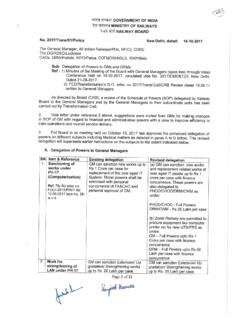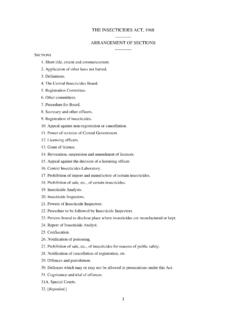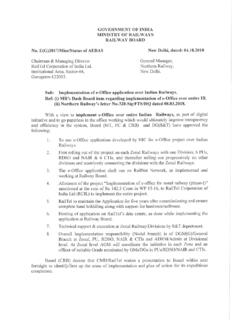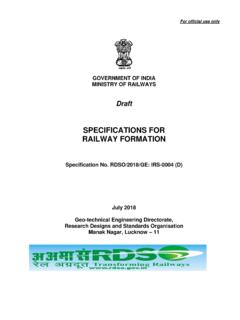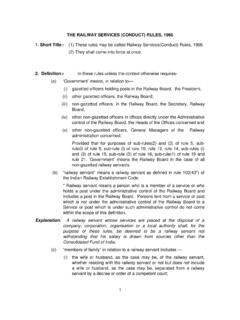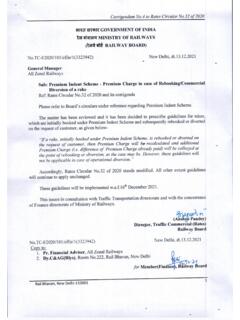Transcription of Question bank for LDC examination ... - Northern Railway zone
1 Question bank for LDC examination General Feature 1. Steep gradients which need extra engine for hauling is known as a) Pusher gradient* b) Rulling Gradient c) Reasonable gradient d) Momentum gradient 2. Rising gradient followed by a falling gradient is known as a) Rulling gradient b) Momentum gradient* c) Pusher graient d) Aangular gradient 3. The safety in Railway in India is looked after by a) ministry of railways b) Commission of Railway Safety* c) Railway board d) Headquarter Office 4. Longest platform of the world on BG is a) At Sonepur station* b) At Sasaram station c) At Allahabad station d) At Kharagpur station 5. The ruling gradient is 1 in 200 on a section of the BG track. If the track is laid in that place at a curve of 5 degrees then the allowable ruling gradient on the curve will be a) 1 in b) 1 and 400 c) 1 in 240 d) 1 in 333* 6. The number of stations on Indian railways is a) 6000 approximately b) 7070 approximately* c) 8000 proximately d) 9000 approximately 7.
2 Longest tunnel on Indian Railway is a) Kharbude tunnel on Konkan Railway * b) Near Lonavala between Monkey hill and Khandala station c) Kalka Shimla d) Darjeeling hill Railway 8. Longest Railway Bridge on Indian Railway is 1. Sone Bridge at Dehri on Sone* 2. Yamuna Bridge at Kalpi 3. Ganga Bridge near Patna 4. Pamban Bridge 9. Longest passenger train on Indian Railway is 1. Prayagraj Express* 2. Kalka Mail 3. Himsagar express 4. Lucknow mail 10. Railway station at the highest altitude on Indian Railway is 1. Ghum station in Darjeeling Himalayan Railway * 2. Shimla station on Kalka Shimla Railway line 3. Mount Abu and Abu Road Mount Road station 4. Joginder Nagar on Pathankot jogindernagar section Track and track gauges Structure for private siding with operating speed of 80 to 100 kmph is same as the track structure as specified for a) Group B route b) Group A route c) Group D route* d)Group C route 2. Track structure for private siding with operating speed 50 to 80 kmph is the same as track structure as specified for a)Group A route b) Group B route c) Group D route d)Group E route* 3.
3 Indicate which of the statement is incorrect with regard to coning of Wheels a)coning of wheels help the vehicle to negotiate a curve smoothly b) It helps in smooth riding c) It increases wear and Tear of wheel flanges* d)it enables the outer wheel of vehicle to take a longer distance e) it restricts the swaying of vehicles 4. Tilting of rails is done at a slope of a. 1 in 30 b. 1 in 25 c. 1 in 20* d. 1 in 15 5. Clear perpendicular distance between inner faces of two rails is a. Gauge of track* b. Inner gauge c. Wheel base d. Wheel gauge 6. The ratio of wheel diameter to gauge is about a. 0. 40 b. c. 0. 75* d. 0. 90 7. The train runs faster on BG than on MG rail because its speed is directly proportional to a) Weight of the train* b) Gauge width c)Policy of Railway board d) Length of the train 8. The ratio of maximum cant e and gauge G in India is about a)1 / 100 b) 1 / 50 c)1 /10* d) 1 / 25 9. Composite sleeper index is employed to determine a) sleeper density requirement b) number of fixtures required for a particular type of sleeper c) durability of sleeper d) mechanical strength of wooden sleepers and thereby gives its suitability as to be used as li sleepers.
4 * 10. The maximum permissible speed recommended for Indian railways for 1 in 8 and half crossing is a)16 kmph* b) 20 kmph c)24 kmph d) 32 kmph is the weight per meter length of 52 kg Rail? a. kg b. kg c. kg* d. kg is the height of 60 kg rail section? a. 180 mm b. 172 mm* c. 185 mm d. 165 mm M+7 sleeper density, how many sleepers are there in a km Track. a. 1660 nos b. 1540 nos.* c. 1310 nos. d. 1440 nos. is the assessed GMT service life of 60 kg 90 UTS rail? a. 650 GMT b. 600 GMT c. 800 GMT* d. 500 GMT is the assessed GMT service life of 52 kg 90 UTS rail. a. 650 GMT b. 600 GMT c. 525 GMT* d. 500 GMT is the full form UTS of rails a. Ultimate technical Strength b. Ultimate tensile Strength* c. Upper Top surface d. None of above is the width of Head of 52 kg Rail section a. 70 mm b. 75 mm c. 67 mm* d. 60 mm is the full form of GMT a. Gross Million Tonnes* b. Gross minimum thickness c. Gross Maximum thickness d.
5 None of above Indian Railway how many Gauges of Track has been adopted a. 1 b. 3* c. 2 d. 4 is the Highest speed of train in Indian Railway a. 140 KMPH b. 120 kmph c. 160 kmph* d. 130 kmph many divisions in Northern Railway a. 5* b. 4 c. 6 d. 3 do you mean by BG a. Big Gauge b. Broad Gauge* c. Buffer gauge d. None of above do you mean by RDSO a. Research & Development Standard organisation* b. Railway Development & Standard organisation c. Regional Development & Standard organisation d. None of above is the Head Quarter of Northern Railway a. New Delhi* b. Lucknow c. Mumbai d. Calcutta is the highest post in Railway a. General Manager b. Chief Engineer c. Chairman Railway board * d. Divisional Railway Manager is the standard distance between lines in Broad Gauge a. 1670 mm b. 1676 mm* c. 1665 mm d. 1680 mm do you mean by LWR a. Long welded Rail* b. Long weld able Rail c. Linear welded rail d. None of above.
6 The basis of temperature how many zones are in Indian Railway a. 2 b. 6 c. 4* d. 7 is the minimum distance centre to centre of straight tracks for new works/alterations to existing works. a. 4265 mm. mm. mm.* d 4365 mm. is the full form of OMS used for track recording a. Outer most Surface b. Oscillation Monitoring system* c. Only measuring system d. Official measurement system is the frequency of track recording of the sections having speed more than 110 kmph to 130 kmph a. 4 Months b. 2 Months c. 6 Months d. 3 Months* is the full form of PQRS used for Track renewal works. a. Plasser quick Relaying system* b. Please quick return services c. Poor Quality renewal system d. None of above radius of curve on Broad gauge a. 175 meter* b. 215 meter c. 146 meter d. 200 meter check rail clearance at Level crossing a. 45 mm b. 51 mm* c. 50 mm d. 57 mm height above rail level of high passenger Platform a.
7 860 mm b. 900 mm c. 840 mm&* d. 875 mm clearance between toe of Open switch and stock rail for new works a. 115 mm* b. 120 mm c. 95 mm d. 110 mm is the formula of TGI for track recording a. UI+4TI+6GI+AI/10 b. 2UI+TI+GI+6AI/10* c. 3UI+TI+2GI+5AI/10 d. 2UI+2tI+2GI+4AI/10 is the limit of Unevenness of A category of track a. 0 to 10 mm b. 0 to 5 mm c. 0 to 6 mm* d. 0 to 8 mm is the difference between rail flange of 60 kg & 52 rail section a. 20 mm b. 18 mm c. 14 mm* d. 16 mm 40. what is the value of long chord for measuring unevenness in track recording a. meter b. meter* c. meter d. meter 41. Frequency of TTM tamping on PSC sleepers track a. 2 years or 100 GMT which ever is earlier* b. 2 years or 150 GMT which ever is earlier c. years or 200 GMT which ever is earlier d. 2 years or 175 GMT which ever is earlier 42. How many sleepers are there in Fan shaped 1 in 12 turnout a. 85 sleepers b. 96 sleepers* c.
8 90 sleepers d. 100 sleepers wing rail clearance opposing nose of crossing on Fan shaped turnout a. 45 mm b. 40 mm c. 41 mm* d. 44 mm length of fan shaped 1 in 12 Turnout a. 39975 mm* b. 41004 mm c. 28613 mm d. None of above is the full form of TGI a. Track Geometry Index* b. Track general Index c. Track gravity Index d. None of above speed of Turnout with 1 in 12 curved switches a. 40 kmph* b. 25 kmph c. 15 kmph d. 20 kmph speed of Turnout with 1 in curved switches a. 40 kmph b. 25 kmph* c. 15 kmph d. 20 kmph many green flags are with Patroller during Hot weather patrolling. a. 02 b. 03 c. 01 d. None of above* level of staff/supervisor competent for TTM tamping operation in LWR/CWR. a. Gang Mate b. PWS c. PWI* d. Keyman. level of staff/supervisor competent for Lifting/Lowering of track in LWR/CWR. a. Keyman. b. Gangmate. c. PWI. d. PWS.* level of staff/supervisor competent for packing or renewal of single isolated sleeper not requiring lifting or slewing of track in LWR/CWR.
9 A. PWI b. Keyman c. Gangmate* d. PWS level of staff/supervisor competent of Renewal of fastenings not requiring lifting in LWR/CWR. a. PWS b. Gangmate c. Keyman* d. Gangman level of staff/supervisor competent for Renewal/recoupment of fastenings requiring lifting in LWR/CWR. a. PWS b. Gangmate* c. Keyman d. Gangman level of staff/supervisor competent for Screening of ballast other than deep screening in LWR/CWR. a. PWS b. Keyman c. Gangmate* d. Gangman level of staff/supervisor competent for Organising Hot weather patrolling during summer months in LWR/CWR. a. Gangmate b. PWI* c. Keyman d. PWS 31. Lowest level of staff/supervisor competent for all operations regarding distressing in LWR/CWR. a. PWI* b. PWS c. Gangmate d. Keyman level of staff/supervisor competent for passing of first train after buckling in LWR/CWR. a. PWI* b. PWS c. Gangmate d. Keyman many zones are in Indian Railway a. 8 b. 10 c. 16* d. 12 LWR What is the range of Destressing temperature in 52 kg and heavier section a.
10 Mean rail temp+5 0C to Mean rail temp+10 0C* b. Mean rail temp+5 0C to Mean rail temp+15 0C c. Mean rail temp to Mean rail temp+10 0C d. Mean rail temp+2 0C to Mean rail temp+10 0C is full form of SPURT car a. Self propelled ultrasonic rail testing car* b. Self pulled united rail testing car c. Self pumped universal testing car d. None of above do you mean by 60 kg rail a. Weight of rail in 1 meter* b. Area of rail of 1 meter c. Weight of rail in 1 feet d. Volume of rail in 1 meter & Crossing is laid at a cant of a. 1 in 20 b. 1 in 10 c. 1 in 15 d. NIL* permissible vertical wear on nose of a 52 kg CMS crossing on Rajdhani route is i) 6mm ii) 8mm* iii) 10mm iv) 12 mm life of detonators is e. 5 years f. 10 years g. 7 years * h. 6 years. distance apart of trolley refuges on bridges with main spans of 100metre or more is i. 50 mtr j. 100 mtr k. 200 mtr l. a refuge over each pair* creep in track is m.

